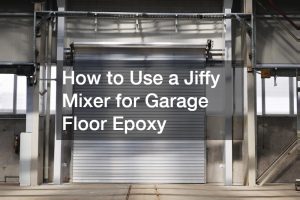
Applying epoxy to a garage floor is a great way to enhance durability, create a professional-looking finish, and protect the surface from stains, moisture, and wear. One of the key tools in this process is a Jiffy Mixer, a specialized mixing attachment designed to efficiently blend epoxy materials. Properly mixing the epoxy is critical to achieving a smooth and even application, and the Jiffy Mixer ensures that the epoxy is well-combined, free of air bubbles, and ready for use. Here’s a step-by-step guide on how to use a Jiffy Mixer for your garage floor epoxy project.
1. Prepare Your Workspace
Before you begin mixing the epoxy, it’s essential to prepare your garage floor and workspace. Clean the garage floor thoroughly by removing any dust, dirt, grease, or stains. Use a broom, vacuum, or pressure washer to ensure the surface is as clean as possible. If there are cracks or uneven surfaces, repair them before applying the epoxy.
Make sure your workspace is well-ventilated, as epoxy fumes can be hazardous. You’ll also need protective gear, including gloves, goggles, and a respirator mask, to avoid exposure to fumes and skin contact with the epoxy mixture.
2. Gather Your Materials
For your garage floor epoxy project, you’ll need the following materials:
Epoxy resin and hardener (usually provided as a two-part kit)
A Jiffy Mixer attachment
A power drill (preferably a variable-speed drill)
A clean, large mixing bucket (often included with the epoxy kit)
Stirring sticks and a paint roller for applying the epoxy
Make sure you’ve read and understood the instructions provided with your epoxy kit, as different products may have specific mixing ratios and curing times.
3. Set Up the Jiffy Mixer
The Jiffy Mixer is a metal mixing attachment designed to be used with a power drill. It’s built to thoroughly mix viscous materials like epoxy without introducing too much air into the mixture, which can lead to bubbles and imperfections in the finish.
Attach the Jiffy Mixer to your drill by securely inserting the mixer shaft into the drill’s chuck. Ensure the mixer is tightly fastened and won’t slip during use. Set your drill to a lower speed to avoid splashing or whipping the epoxy.
4. Mix the Epoxy Properly
Once your setup is ready, it’s time to mix the epoxy. Epoxy floor coatings typically come in two parts: the resin and the hardener. Carefully pour the resin and hardener into a clean mixing bucket, making sure to follow the manufacturer’s recommended mixing ratio. The ratio is usually 1:1 or 2:1, depending on the product.
Turn on your drill at a low speed and lower the Jiffy Mixer into the epoxy mixture. Begin mixing the epoxy slowly, moving the mixer around the bottom and sides of the bucket to ensure all components are thoroughly blended. Gradually increase the speed of the drill to create a smooth, homogenous mixture. Avoid running the drill at high speed, as this can cause air bubbles to form in the epoxy.
Mix for the recommended time, typically 3-5 minutes, until the epoxy is completely combined. The mixture should have a uniform color and consistency with no streaks or unmixed portions. Proper mixing is crucial to ensure that the epoxy cures correctly on the garage floor.
5. Apply the Epoxy
Once the epoxy is fully mixed, you’ll need to apply it quickly, as epoxy begins to harden once the resin and hardener are combined. Pour the mixture onto the garage floor in small sections, using a roller or squeegee to spread it evenly across the surface.




